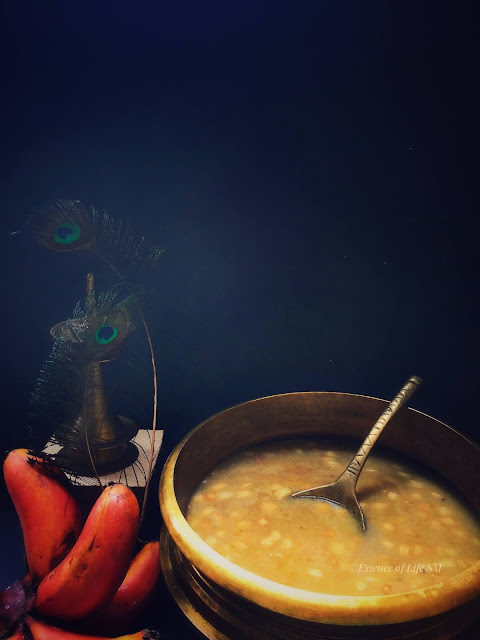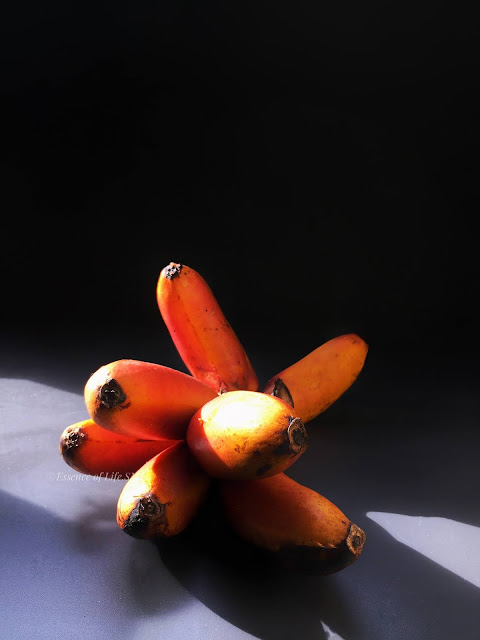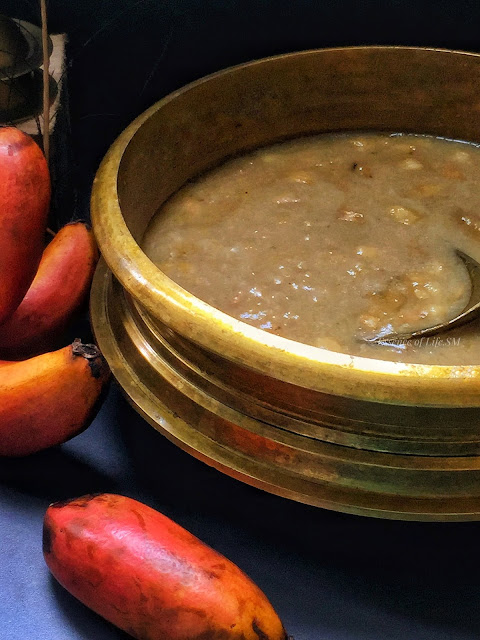 |
Aravana Payasam: A Tribute on a Special Anniversary
Today marks a momentous occasion—the 50th Wedding Anniversary of my beloved parents. Unfortunately, circumstances prevented me from celebrating this special day alongside them. To honor their love and this significant milestone from afar, I've decided to revisit a cherished recipe that resonates deeply with every Malayali heart: Aravana Payasam.
Aravana Payasam isn't just any dessert; it's a divine offering, deeply ingrained in Kerala's temple traditions, particularly famous as the Prasadham at Sabarimala. This thick, luscious dessert is meticulously slow-cooked, combining raw rice (Unakkalari) with generous amounts of ghee and jaggery. Each spoonful of this payasam carries the essence of devotion and tradition, designed to be savoured slowly, in small quantities, reflecting its rich and intense flavours. It is also called as Kadumpayasam/Kadumadhura Payasam or the strong payasam in terms of its sweetness.
This dish not only celebrates a union but also connects us through flavours to our spiritual heritage, making each bite a tribute to both divine and earthly love.
Aravana Payasam isn't just a dish; it's a cherished memory of divinity from my childhood visits to Sabarimala. This revered sweet dish is the quintessential Prasadham at the Sabarimala Shree Ayyappa Swami Temple, representing an important offering during the Mandalam-Makaravilakku pilgrimage season. Reflecting on the past, I vividly recall how my father would bring home this delightful payasam in small plastic containers—a tradition that marked every visit.
Traditionally, Aravana Payasam was prepared in large stone and brass wares at the temple, though now it is more commonly tinned to meet the high demand and ensure longer shelf life. This adaptation highlights its importance and the evolving practices of its preparation.
The recipe for Aravana Payasam is deceptively simple, requiring only three ingredients: Unakkalari (raw rice), Jaggery, and Ghee. Yet, its preparation is imbued with devotion and care, especially when my father makes it. Not only does he prepare it for our neighbourhood temple during Mandala Kaalam, but it also serves as a vital part of Mandalakala(Ayyappa) Puja and Annadhanam.
Having finally persuaded my father to write down his method, I treasure his handwritten recipe, especially the succinct final note that beautifully encapsulates the essence of this divine dish. His ability to distil complex processes into simple, memorable steps is what makes him an excellent teacher.
 |
Perfecting Aravana Payasam: A Guide to Proportions
When crafting the traditional Aravana Payasam, understanding the right proportions of ingredients is crucial for achieving its unique taste and texture. For those who may struggle with deciphering handwritten recipes, here’s a clear breakdown of the essential measurements needed to prepare this divine dessert.
For every cup of Unakkalari (raw rice) used, the recipe calls for four cups of Jaggery, enhancing the sweetness that characterizes this beloved prasadham. Complementing these are half a cup of Ghee and half a cup of coconut slices, which introduce a rich, creamy texture and a subtle tropical flavour to the dish.
In simpler terms, the ratio for making Aravana Payasam can be remembered as: 1 part rice, 4 parts Jaggery, 0.5 part Ghee, and 0.5 part coconut slices. This guideline ensures that even novice cooks can achieve the authentic taste that makes Aravana Payasam a standout dish during religious festivities and temple offerings in Kerala.
 |
A Symbolic Presentation of Aravana Payasam as Temple Offering |
Exploring the Historical Roots of Aravana Payasam and its Spiritual Significance
Before delving into the recipe for Aravana Payasam, it's essential to appreciate its rich historical and spiritual background. This cherished dish, synonymous with the sacred Ayyappa Prasadham, boasts a profound origin that resonates deeply with devotees.
There are two predominant tales that explain the inception of Aravana Payasam. The most celebrated narrative involves Aravana Rishi. According to legend, this revered sage first prepared the dish as an offering to Lord Ayyappan at the Sabarimala Temple, which is nestled deep within a lush forest. In ancient times, pilgrims would journey for days, navigating through dense woods to reach the temple, carrying basic provisions like Unakkalari (raw rice). The Payasam was likely concocted from these simple ingredients to not only serve as an offering, but also to sustain the devotees due to its longer shelf life.
A second story suggests the name ‘Aravana’ derives from an old interpretation for 'God'. In this view, the sweet Payasam cooked for the deity was thus fittingly named Aravana Payasam, emphasizing its divine purpose.
Both stories highlight the Payasam's enduring significance as more than just food; it's a divine offering steeped in tradition and devotion, integral to the worship practices at Sabarimala. This background enriches the cultural and spiritual value of Aravana Payasam, making it a pivotal element of the temple's lore and festivities.
 |
The exquisite blend of Unakkalari (raw rice) and Sarkkara (jaggery) in Aravana Payasam never fails to amaze me. It's a testament to how prasadhams, or offerings, transcend mere taste to satisfy both palate and soul. At home, my parents excel in crafting the finest Neypayasam and Aravana Payasam, often preparing them for Annadhanam, a noble tradition of feeding the community.
The aroma of Aravana Payasam simmering with ghee and jaggery fills my entire house with a divine essence. Yet, its essence truly shines in temple settings, where its sweetness and richness are unparalleled. Remember, this delicacy is best enjoyed in small servings, with just a spoonful enough to relish its robust flavours.
Explore more delightful recipes on Payasam, Pradhamans, and Kheers to discover the diverse flavours and cultural heritage they offer.
Cuisine - Kerala (India)
Recipe Type - Pradhaman/Payasam, Dessert
Difficulty - Easy
Serves - 4- 6
Author - SM
Preparation Time - 15-25 Minutes
Cooking Time - 20 -30 Minutes
How to Cook Sabarimala Aravana Payasam at Home
 |
Ingredients for Traditional Aravana Payasam Recipe:
To Cook the Rice:
1 Cup Raw Rice(Unakkalari)
1.5 - 2 Cups of Water
For Aravana Payasam:
1/2 Cup Ghee
1/2 Cup Coconut Slices
4-5 Cardamom Pods
1/2 Teaspoon Dry Ginger Powder
 |
| Delicious Aravana Payasam for Prasadham |
Step-by-Step Method to Prepare Aravana Payasam
To ensure your Aravana Payasam turns out perfect every time, follow these detailed steps:
Preparations:
- Grind cardamom into a fine powder and set aside.
- Grind Dry Ginger into a fine powder and set aside.
- Slice coconut into small pieces.
Jaggery Preparation:
- In a separate pot, melt Jaggery in 1.5 cups of water. Boil until fully dissolved, then strain to remove any impurities.
Rice Preparation:
- Rinse the Unakkalari (raw rice) thoroughly 2-3 times until the water runs clear to remove excess starch.
Cooking the Rice:
- Pressure Cooker - Pressure-cook the rinsed rice with 1.5 cups of water. Bring to high pressure and cook for 1 whistle, then lower the flame and cook for an additional 2-3 whistles. Allow the pressure to release naturally.
- Saucepan - Alternatively, cook the rice in a saucepan by boiling 2 cups of water and adding the rice. Cook until it's 3/4 done.
Cooking Aravana Payasam:
- Heat ghee in a heavy-bottomed pan (like a brass Uruli) and fry coconut slices until they turn light golden brown.
- Pour the melted Jaggery into the pan with fried coconut. Cook on low heat for a few minutes.
- Gently add the cooked rice to the mixture, ensuring thorough mixing.
- Cook on a very low flame, stirring continuously, until the rice absorbs the Jaggery solution.
- Add cardamom powder and dry ginger powder. Continue cooking until the Aravana Payasam begins to leave the sides of the pan.
Adjusting the Consistency:
- Adjust the consistency to your liking by adding more water if needed.
Serving:
- Once done, switch off the flame and serve the Aravana Payasam hot or warm.
- For a delightful twist, serve with a banana on the side.
 |
Key Notes for Perfecting Aravana Payasam
Here are essential tips to enhance your Aravana Payasam preparation:
- Choice of Rice: This recipe uses raw rice, ideally Unakkalari. Adjust water and cooking time accordingly for best results.
- Alternative Rice Options: Kerala Matta Rice or Unakkalari (Raw Kerala Rice) can also be used. When using Kerala Matta Rice, cook 1 cup of rice with 5 cups of water.
- Cooking Methods: Aravana Payasam can be cooked in a saucepan, pressure cooker, or rice cooker. Adjust water levels as needed, especially when using a saucepan, to achieve desired consistency.
- Sweetness Adjustment: Aravana Payasam is known for its sweetness. Adjust the amount of jaggery to suit personal taste preferences.
- Additional Ingredients: For added richness, consider incorporating fried cashew nuts, raisins, and coconut slices in ghee. *Note, however, that traditionally Aravana Payasam as Prasadham does not include these add-ons.
Mastering the art of preparing Aravana Payasam unlocks a gateway to Kerala's rich culinary heritage and spiritual traditions. Whether using Unakkalari or Kerala Matta Rice, the key lies in balancing ingredients like jaggery, ghee, and coconut to achieve its signature sweetness and depth of flavour. Remember, this beloved prasad can be savored in moderation, making each spoonful a divine experience. Explore the nuances of this timeless dessert, perfect for religious offerings and festive celebrations alike, and bring home the essence of Kerala with every aromatic serving of Aravana Payasam.
Aravana Payasam - Mastering the Taste of Kerala's Divine Delight
Aravana Payasam - Traditional Kerala Dessert






























